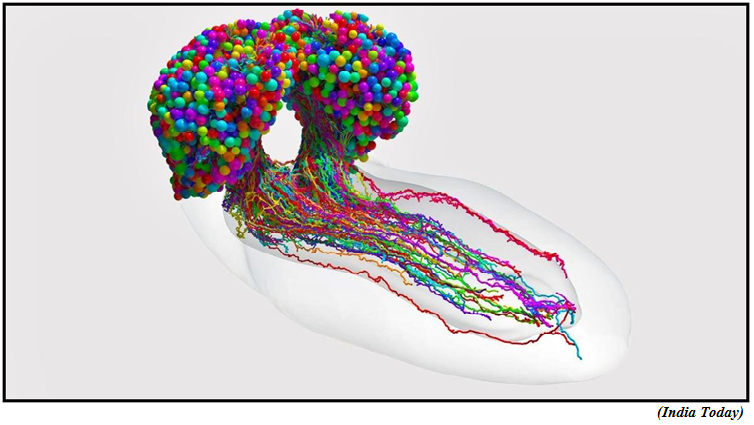Scientists make the first complete map of insect brain (GS Paper 3, Science and Tech)

Why in news?
- Recently, the researchers have for the first time created a detailed map of an insect's brain, which shows every single neuron and how they’re wired together. The brain is of the fruit fly larva.
Details:
- Research into brain mapping has been going on for decades and it's a difficult task since it requires slicing the brain into hundreds or thousands of individual tissue samples, all of which have to be imaged with electron microscopes before the painstaking process of reconstructing all those pieces.
- Led by Johns Hopkins University, researchers from UK, US, and Germany, produced the first detailed neural diagram of an insect's brain that could enhance future brain research and develop new ways to learn its architecture.
How was the research conducted?
- The study targeted Drosophila melanogaster larva, which shares much of its fundamental biology with humans, including a comparable genetic foundation. The insect has rich learning and decision-making behaviors as well.
- Researchers mapped 3,016 neurons and every connection between them, which came to nearly 5, 48,000.
- Researchers at Cambridge University created high-resolution images of the brain and manually studied them to find individual neurons. While the research was spanned over 12 years, imaging alone took about a day per neuron.
- The data was then handed to researchers at Johns Hopkins, who spent more than three years using the original code they created to analyze the brain's connectivity.
- They also developed techniques to find groups of neurons based on shared connectivity patterns. The team then came together to chart every neuron and every connection and categorized each neuron by the role it plays in the brain.
Way Forward:
- The fruit fly larva work showed circuit features that were strikingly reminiscent of prominent and powerful machine learning architectures.
- The neuroscience breakthrough has brought scientists closer to understanding the mechanism of thought.
House panel pulls up Labour Ministry for underutilisation of allocations for its schemes
(GS Paper 2, Governance)
Why in news?
- Recently, the Parliamentary Standing Committee on Labour, headed by Biju Janata Dal (BJD) leader BhartruhariMahtab, has pulled up the Union Labour Ministry for underutilisation of the allocations meant for the Ministry’s schemes.

Details:
- The panel has asked the Ministry to assess and work out the likely financial implication for implementing the Supreme Court judgment on higher provident fund pension and approach the Ministry of Finance for additional funds to enable timely payment of amounts that may become due.
- The panel noted that ₹16,893.68 crore was allocated as Budget estimates 2022-23, which was decreased to ₹16,117.65 crore at revised estimates stage whereas the actual expenditure incurred as on February 21, 2023 was ₹ 13,092.99 crore, which amounts to 81.23% of the revised estimates (RE) amount.
Scheme-wise analysis:
- The scheme-wise analysis of utilisation of funds for the fiscal 2022-23 up to February 13, 2023 reveals that the Employee’s Pension Scheme (EPS) and National Career Services (NCS) are the only schemes which recorded expenditure up to 90% vis-à-vis RE provisioning whereas for most other schemes, the percentage utilisation has been substantially low.
- In case of Pradhan Mantri Shram Yogi Maandhan, National Database of Unorganised Workers, Labour Welfare Schemes and Rehabilitation of Bonded Labour, the utilisation recorded has been 26.66%, 30.02%, 30.63% and 48.30%, respectively vis-à-vis the Budget provisioning.
- The panel observed that gross underutilisation of the funds has impacted the performance of certain schemes thereby defeating the laudable intent of these schemes in benefiting the targeted groups.
Conclusion:
- The committee, therefore, impress upon the Ministry to leverage their spending pattern on such schemes where the utilisation percentage is not up to the mark so as to ensure optimal achievement of the 2022-23 allocations by the close of the Financial Year, 2022-23.
India remains world’s largest importer of arms: SIPRI report
(GS Paper 3, Defence)
Why in news?
- India remained the world’s largest arms importer for the five-year period between 2018 and 2022 even though its arms imports dropped by 11% between 2013-2017 and 2018-2022, according to the Swedish think tank Stockholm International Peace Research Institute (SIPRI).
- Russia was the largest supplier of arms to India from 2013 to 2022, but its share of total imports fell from 64% to 45% while France is the second largest supplier.

India as exporter:
- As per latest SIPRI data, among the top 10 arms exporters for the period 2018 to 2022, India was the biggest arms export market to three countries; Russia, France and Israeland the second largest export market to South Korea.
- India was also the third largest market for South Africa, which was ranked 21 in the list of arms exporters.
India as importer:
- For the same period, India remained the largest arms importer followed by Saudi Arabia. Russia accounted for 45% of India’s imports followed by France (29%) and the U.S. (11%).
- Also, India was the third largest arms supplier to Myanmar after Russia and China accounting for 14% of its imports.
- India’s arms imports from France, which included 62 combat aircraft and four submarines, increased by 489% between 2013 to 2017 and 2018 to 2022. France therefore displaced the U.S. to become the second largest supplier to India in 2018 to 2022.
Observations:
- India’s tensions with Pakistan and China largely drive its demand for arms imports. With an 11% share of total global arms imports, India was the world’s biggest importer of major arms in 2018 to 2022, a position it has held for the period 1993 to 2022.
- It retained this position even though its arms imports dropped by 11% between 2013 to 2017 and 2018 to 2022.
- The decrease can be attributed to several factors including India’s slow and complex arms procurement process, efforts to diversify its arms suppliers, and attempts to replace imports with major arms that are designed and produced domestically.
Russian arm’s export to India:
- The Russia’s position as India’s main arms supplier is under pressure due to strong competition from other supplier states, increased Indian arms production and, since 2022, also the impact of war in Ukraine
- Just under two thirds of Russian exports went to three states from 2018 to 2022; India (31%), China (23%) and Egypt (9.3%). India was also the largest recipient of Russian arms from 2013 to 2017, but exports decreased by 37% between the two periods.




